HND Travel & Tourism: Analyzing Industry Development and Global Trends
VerifiedAdded on 2022/12/06
|15
|4375
|314
Report
AI Summary
This report provides a comprehensive analysis of the contemporary travel and tourism industry, exploring key milestones in its development, the various elements that constitute the industry, and their interconnectedness in shaping the tourism experience. It delves into factors affecting tourist behavior, the influence of motivation models on consumer decision-making, and current trends in international travel and tourism. Furthermore, the report examines the factors driving the popularity of different global destinations. The analysis covers aspects such as transportation advancements, accommodation options, food and beverage services, and the role of tourist boards in promoting tourism. Motivation theories, including drive theory, homeostasis, and Maslow's hierarchy of needs, are discussed in the context of their impact on consumer choices within the tourism sector. This document is contributed by a student and available on Desklib, a platform offering a range of study tools and resources for students.

The Contemporary Travel
and Tourism Industry
and Tourism Industry
Paraphrase This Document
Need a fresh take? Get an instant paraphrase of this document with our AI Paraphraser
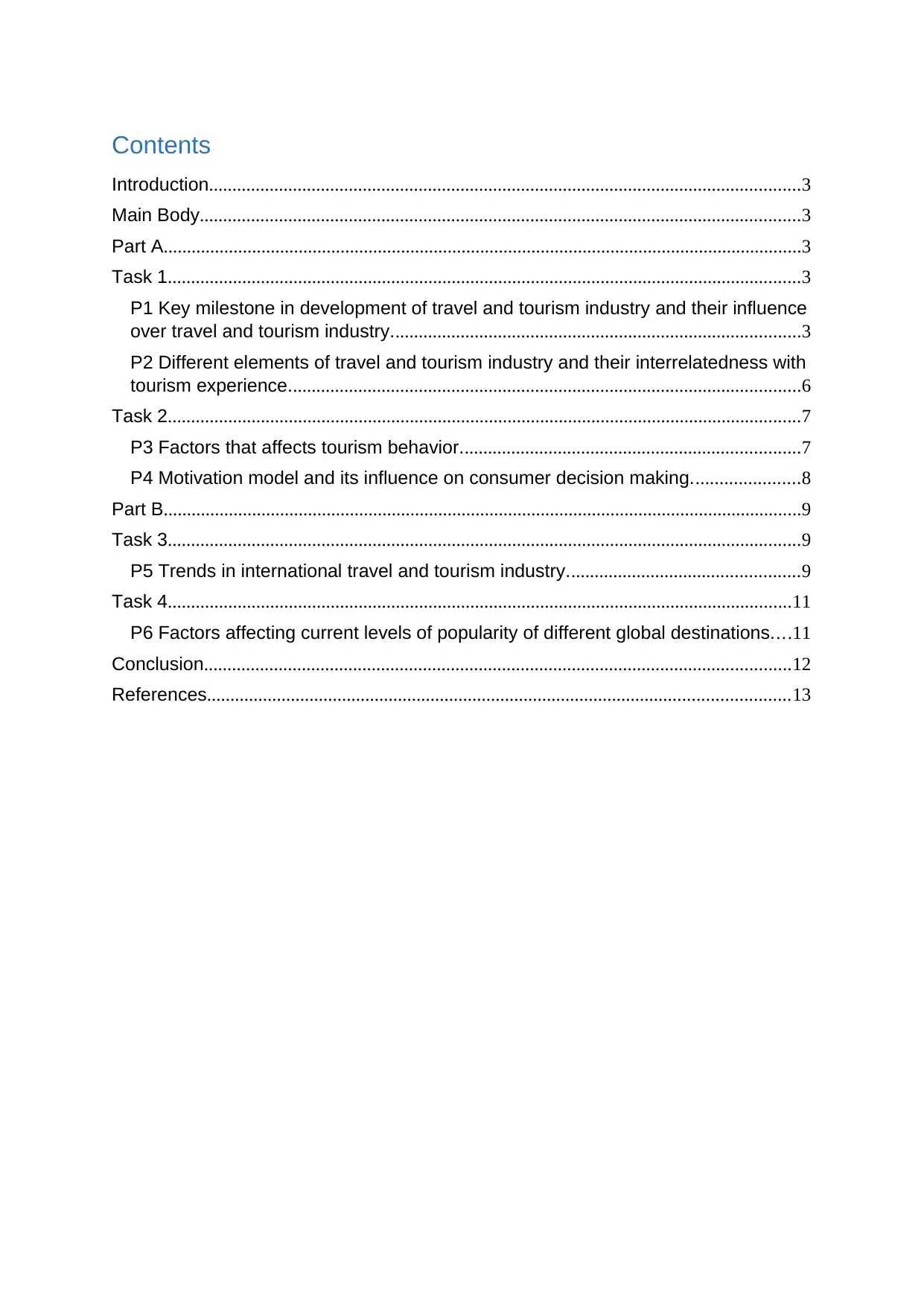
Contents
Introduction...............................................................................................................................3
Main Body.................................................................................................................................3
Part A.........................................................................................................................................3
Task 1........................................................................................................................................3
P1 Key milestone in development of travel and tourism industry and their influence
over travel and tourism industry........................................................................................3
P2 Different elements of travel and tourism industry and their interrelatedness with
tourism experience..............................................................................................................6
Task 2........................................................................................................................................7
P3 Factors that affects tourism behavior.........................................................................7
P4 Motivation model and its influence on consumer decision making.......................8
Part B.........................................................................................................................................9
Task 3........................................................................................................................................9
P5 Trends in international travel and tourism industry..................................................9
Task 4......................................................................................................................................11
P6 Factors affecting current levels of popularity of different global destinations....11
Conclusion..............................................................................................................................12
References.............................................................................................................................13
Introduction...............................................................................................................................3
Main Body.................................................................................................................................3
Part A.........................................................................................................................................3
Task 1........................................................................................................................................3
P1 Key milestone in development of travel and tourism industry and their influence
over travel and tourism industry........................................................................................3
P2 Different elements of travel and tourism industry and their interrelatedness with
tourism experience..............................................................................................................6
Task 2........................................................................................................................................7
P3 Factors that affects tourism behavior.........................................................................7
P4 Motivation model and its influence on consumer decision making.......................8
Part B.........................................................................................................................................9
Task 3........................................................................................................................................9
P5 Trends in international travel and tourism industry..................................................9
Task 4......................................................................................................................................11
P6 Factors affecting current levels of popularity of different global destinations....11
Conclusion..............................................................................................................................12
References.............................................................................................................................13

Introduction
Tourism and travel terms have very similar relationships, with considerable
similarities between the travel and tourism industries. However, the two words and the two
sectors still vary. Hospitality is commonly seen as travel with business and leisure purposes
to a particular place. In fact, it does have a very precise meaning, however: the action of
travelling in a different environment for business or leisure activities by at least 24 hours
though not for more than one year. Travel relates mostly to move from place to place. This
may include long journeys, short journeys, foreign journeys, domestic journeys and various
other types. Travel also involves round trips that one-way trips and covers a wide range of
various travel destinations. Thus, the travel sector relates to the many facets of the broader
service industry that respond to the needs and wishes of people who have travelled around
the globe. This report will highlight various key aspects related to tourism industry and will
focus on application of various motivational tool that can be prove useful to attract more and
more customers for the business firm (Ajanthan, 2017).
Main Body
Part A
Task 1
P1 Key milestone in development of travel and tourism industry and their influence over
travel and tourism industry.
Tourism is the temporary travel from the places of employment and homes to a
certain location, sports in the destinations and the amenities that have arisen to meet the
requirements at some stage in their stay (Chen, 2018). In previous times travel and tourism
industries have been experienced with significant changes in terms of its operational
working. People today consider such industries as a part of their luxuries life style. In past
there were several historical changes being experienced in these sectors. The changes were
in respect to technology, quality of services and improved customer relations.
Consequently, the future of tourism and tourism is split into six stages which can be
discussed below:
1.0 Transportation
One of the main aspects of the traffic and tourism industries is the transport
(accessibility) scheme. It is regarded as a connection between regions that generate tourism
and areas of tourism destinations. Any of the world's largest carriers are,
Tourism and travel terms have very similar relationships, with considerable
similarities between the travel and tourism industries. However, the two words and the two
sectors still vary. Hospitality is commonly seen as travel with business and leisure purposes
to a particular place. In fact, it does have a very precise meaning, however: the action of
travelling in a different environment for business or leisure activities by at least 24 hours
though not for more than one year. Travel relates mostly to move from place to place. This
may include long journeys, short journeys, foreign journeys, domestic journeys and various
other types. Travel also involves round trips that one-way trips and covers a wide range of
various travel destinations. Thus, the travel sector relates to the many facets of the broader
service industry that respond to the needs and wishes of people who have travelled around
the globe. This report will highlight various key aspects related to tourism industry and will
focus on application of various motivational tool that can be prove useful to attract more and
more customers for the business firm (Ajanthan, 2017).
Main Body
Part A
Task 1
P1 Key milestone in development of travel and tourism industry and their influence over
travel and tourism industry.
Tourism is the temporary travel from the places of employment and homes to a
certain location, sports in the destinations and the amenities that have arisen to meet the
requirements at some stage in their stay (Chen, 2018). In previous times travel and tourism
industries have been experienced with significant changes in terms of its operational
working. People today consider such industries as a part of their luxuries life style. In past
there were several historical changes being experienced in these sectors. The changes were
in respect to technology, quality of services and improved customer relations.
Consequently, the future of tourism and tourism is split into six stages which can be
discussed below:
1.0 Transportation
One of the main aspects of the traffic and tourism industries is the transport
(accessibility) scheme. It is regarded as a connection between regions that generate tourism
and areas of tourism destinations. Any of the world's largest carriers are,
⊘ This is a preview!⊘
Do you want full access?
Subscribe today to unlock all pages.

Trusted by 1+ million students worldwide
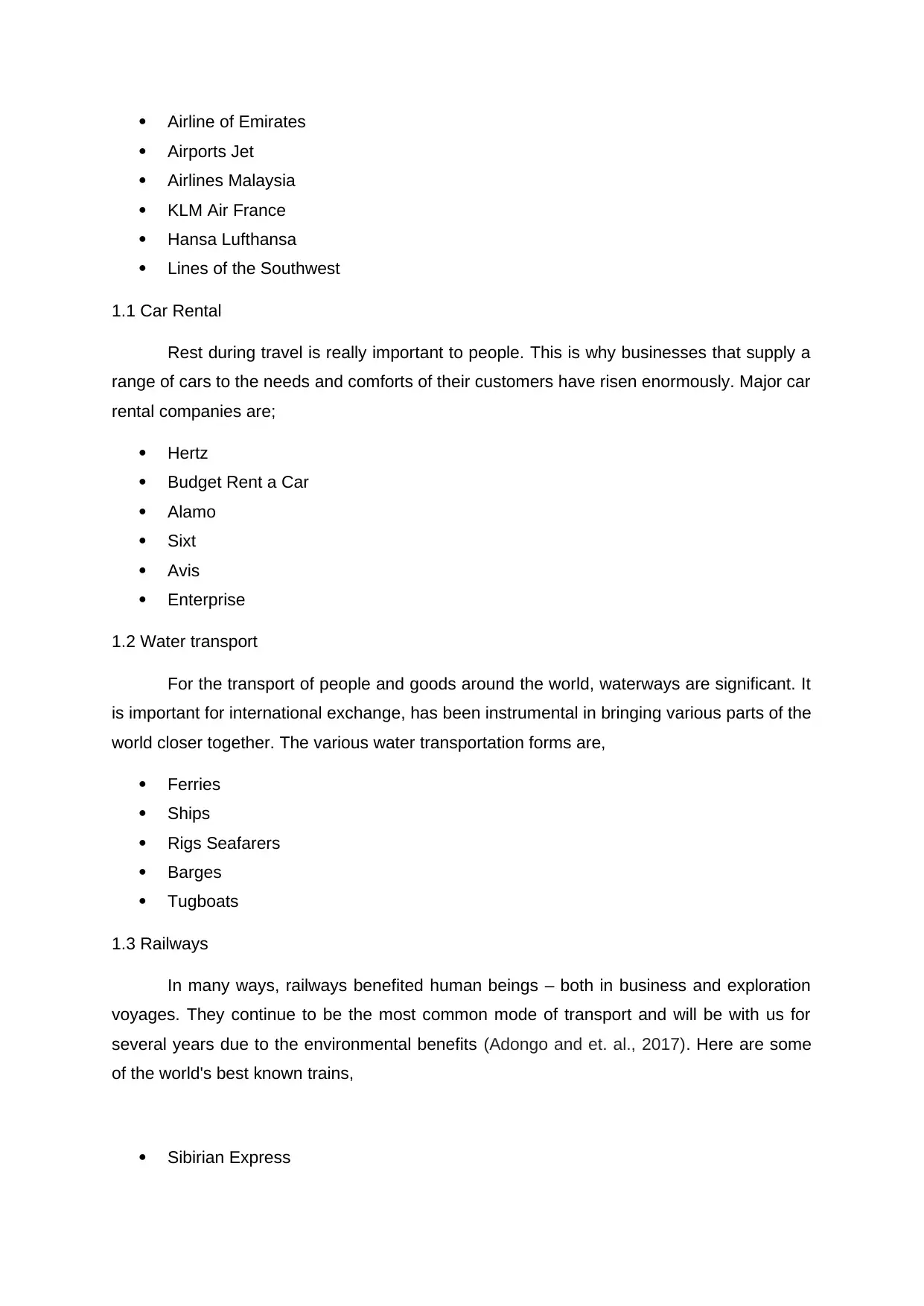
Airline of Emirates
Airports Jet
Airlines Malaysia
KLM Air France
Hansa Lufthansa
Lines of the Southwest
1.1 Car Rental
Rest during travel is really important to people. This is why businesses that supply a
range of cars to the needs and comforts of their customers have risen enormously. Major car
rental companies are;
Hertz
Budget Rent a Car
Alamo
Sixt
Avis
Enterprise
1.2 Water transport
For the transport of people and goods around the world, waterways are significant. It
is important for international exchange, has been instrumental in bringing various parts of the
world closer together. The various water transportation forms are,
Ferries
Ships
Rigs Seafarers
Barges
Tugboats
1.3 Railways
In many ways, railways benefited human beings – both in business and exploration
voyages. They continue to be the most common mode of transport and will be with us for
several years due to the environmental benefits (Adongo and et. al., 2017). Here are some
of the world's best known trains,
Sibirian Express
Airports Jet
Airlines Malaysia
KLM Air France
Hansa Lufthansa
Lines of the Southwest
1.1 Car Rental
Rest during travel is really important to people. This is why businesses that supply a
range of cars to the needs and comforts of their customers have risen enormously. Major car
rental companies are;
Hertz
Budget Rent a Car
Alamo
Sixt
Avis
Enterprise
1.2 Water transport
For the transport of people and goods around the world, waterways are significant. It
is important for international exchange, has been instrumental in bringing various parts of the
world closer together. The various water transportation forms are,
Ferries
Ships
Rigs Seafarers
Barges
Tugboats
1.3 Railways
In many ways, railways benefited human beings – both in business and exploration
voyages. They continue to be the most common mode of transport and will be with us for
several years due to the environmental benefits (Adongo and et. al., 2017). Here are some
of the world's best known trains,
Sibirian Express
Paraphrase This Document
Need a fresh take? Get an instant paraphrase of this document with our AI Paraphraser
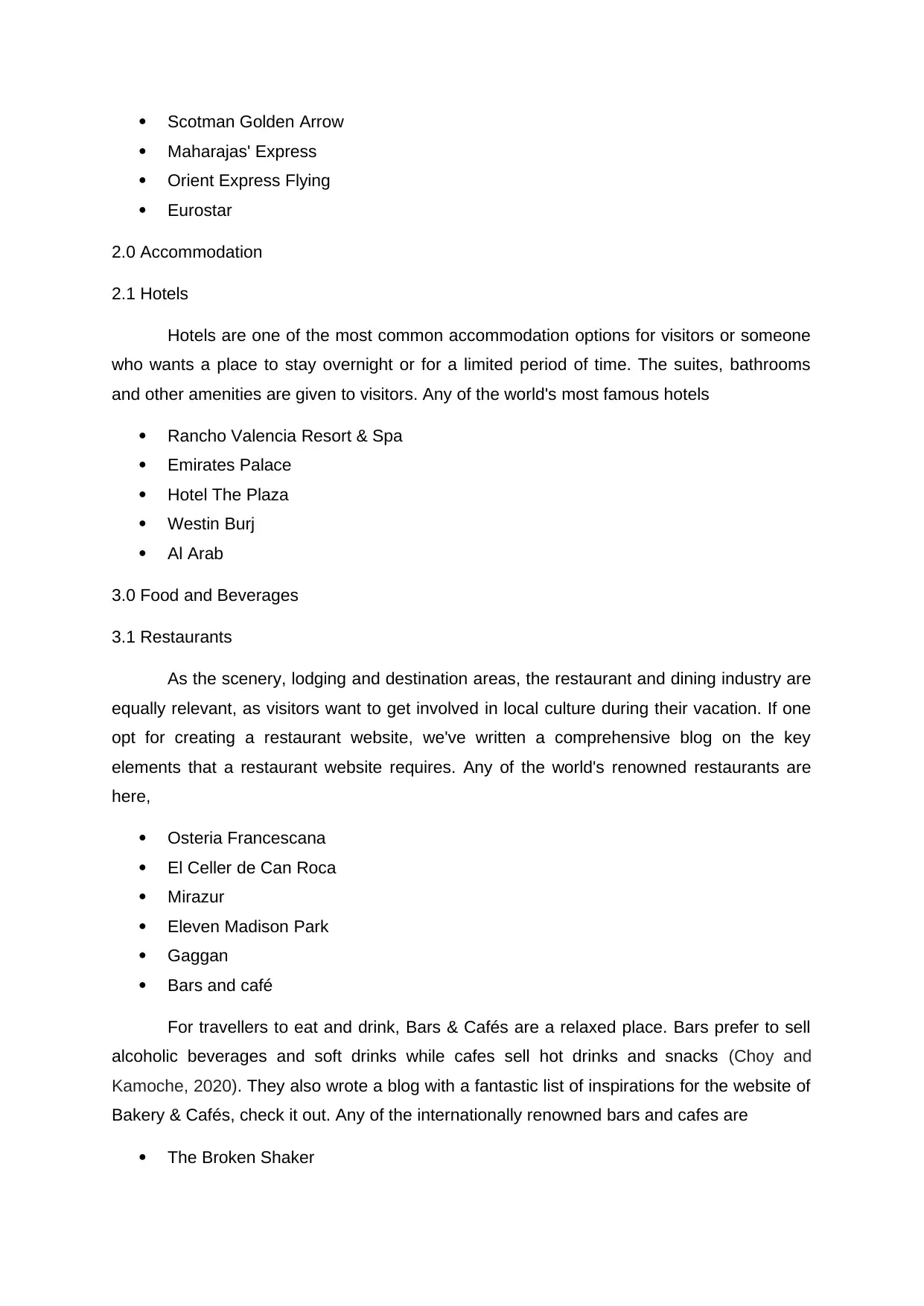
Scotman Golden Arrow
Maharajas' Express
Orient Express Flying
Eurostar
2.0 Accommodation
2.1 Hotels
Hotels are one of the most common accommodation options for visitors or someone
who wants a place to stay overnight or for a limited period of time. The suites, bathrooms
and other amenities are given to visitors. Any of the world's most famous hotels
Rancho Valencia Resort & Spa
Emirates Palace
Hotel The Plaza
Westin Burj
Al Arab
3.0 Food and Beverages
3.1 Restaurants
As the scenery, lodging and destination areas, the restaurant and dining industry are
equally relevant, as visitors want to get involved in local culture during their vacation. If one
opt for creating a restaurant website, we've written a comprehensive blog on the key
elements that a restaurant website requires. Any of the world's renowned restaurants are
here,
Osteria Francescana
El Celler de Can Roca
Mirazur
Eleven Madison Park
Gaggan
Bars and café
For travellers to eat and drink, Bars & Cafés are a relaxed place. Bars prefer to sell
alcoholic beverages and soft drinks while cafes sell hot drinks and snacks (Choy and
Kamoche, 2020). They also wrote a blog with a fantastic list of inspirations for the website of
Bakery & Cafés, check it out. Any of the internationally renowned bars and cafes are
The Broken Shaker
Maharajas' Express
Orient Express Flying
Eurostar
2.0 Accommodation
2.1 Hotels
Hotels are one of the most common accommodation options for visitors or someone
who wants a place to stay overnight or for a limited period of time. The suites, bathrooms
and other amenities are given to visitors. Any of the world's most famous hotels
Rancho Valencia Resort & Spa
Emirates Palace
Hotel The Plaza
Westin Burj
Al Arab
3.0 Food and Beverages
3.1 Restaurants
As the scenery, lodging and destination areas, the restaurant and dining industry are
equally relevant, as visitors want to get involved in local culture during their vacation. If one
opt for creating a restaurant website, we've written a comprehensive blog on the key
elements that a restaurant website requires. Any of the world's renowned restaurants are
here,
Osteria Francescana
El Celler de Can Roca
Mirazur
Eleven Madison Park
Gaggan
Bars and café
For travellers to eat and drink, Bars & Cafés are a relaxed place. Bars prefer to sell
alcoholic beverages and soft drinks while cafes sell hot drinks and snacks (Choy and
Kamoche, 2020). They also wrote a blog with a fantastic list of inspirations for the website of
Bakery & Cafés, check it out. Any of the internationally renowned bars and cafes are
The Broken Shaker
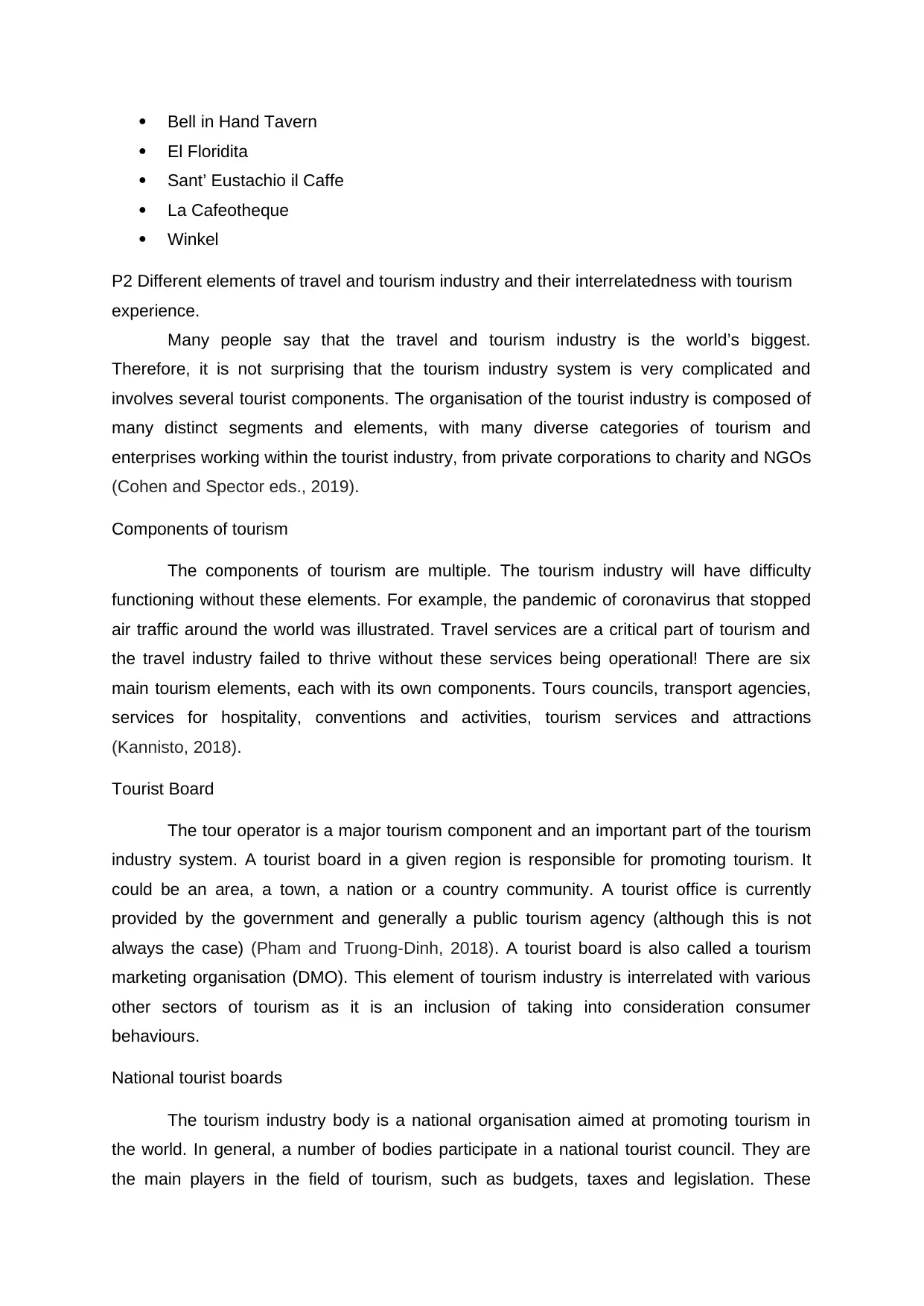
Bell in Hand Tavern
El Floridita
Sant’ Eustachio il Caffe
La Cafeotheque
Winkel
P2 Different elements of travel and tourism industry and their interrelatedness with tourism
experience.
Many people say that the travel and tourism industry is the world’s biggest.
Therefore, it is not surprising that the tourism industry system is very complicated and
involves several tourist components. The organisation of the tourist industry is composed of
many distinct segments and elements, with many diverse categories of tourism and
enterprises working within the tourist industry, from private corporations to charity and NGOs
(Cohen and Spector eds., 2019).
Components of tourism
The components of tourism are multiple. The tourism industry will have difficulty
functioning without these elements. For example, the pandemic of coronavirus that stopped
air traffic around the world was illustrated. Travel services are a critical part of tourism and
the travel industry failed to thrive without these services being operational! There are six
main tourism elements, each with its own components. Tours councils, transport agencies,
services for hospitality, conventions and activities, tourism services and attractions
(Kannisto, 2018).
Tourist Board
The tour operator is a major tourism component and an important part of the tourism
industry system. A tourist board in a given region is responsible for promoting tourism. It
could be an area, a town, a nation or a country community. A tourist office is currently
provided by the government and generally a public tourism agency (although this is not
always the case) (Pham and Truong-Dinh, 2018). A tourist board is also called a tourism
marketing organisation (DMO). This element of tourism industry is interrelated with various
other sectors of tourism as it is an inclusion of taking into consideration consumer
behaviours.
National tourist boards
The tourism industry body is a national organisation aimed at promoting tourism in
the world. In general, a number of bodies participate in a national tourist council. They are
the main players in the field of tourism, such as budgets, taxes and legislation. These
El Floridita
Sant’ Eustachio il Caffe
La Cafeotheque
Winkel
P2 Different elements of travel and tourism industry and their interrelatedness with tourism
experience.
Many people say that the travel and tourism industry is the world’s biggest.
Therefore, it is not surprising that the tourism industry system is very complicated and
involves several tourist components. The organisation of the tourist industry is composed of
many distinct segments and elements, with many diverse categories of tourism and
enterprises working within the tourist industry, from private corporations to charity and NGOs
(Cohen and Spector eds., 2019).
Components of tourism
The components of tourism are multiple. The tourism industry will have difficulty
functioning without these elements. For example, the pandemic of coronavirus that stopped
air traffic around the world was illustrated. Travel services are a critical part of tourism and
the travel industry failed to thrive without these services being operational! There are six
main tourism elements, each with its own components. Tours councils, transport agencies,
services for hospitality, conventions and activities, tourism services and attractions
(Kannisto, 2018).
Tourist Board
The tour operator is a major tourism component and an important part of the tourism
industry system. A tourist board in a given region is responsible for promoting tourism. It
could be an area, a town, a nation or a country community. A tourist office is currently
provided by the government and generally a public tourism agency (although this is not
always the case) (Pham and Truong-Dinh, 2018). A tourist board is also called a tourism
marketing organisation (DMO). This element of tourism industry is interrelated with various
other sectors of tourism as it is an inclusion of taking into consideration consumer
behaviours.
National tourist boards
The tourism industry body is a national organisation aimed at promoting tourism in
the world. In general, a number of bodies participate in a national tourist council. They are
the main players in the field of tourism, such as budgets, taxes and legislation. These
⊘ This is a preview!⊘
Do you want full access?
Subscribe today to unlock all pages.

Trusted by 1+ million students worldwide
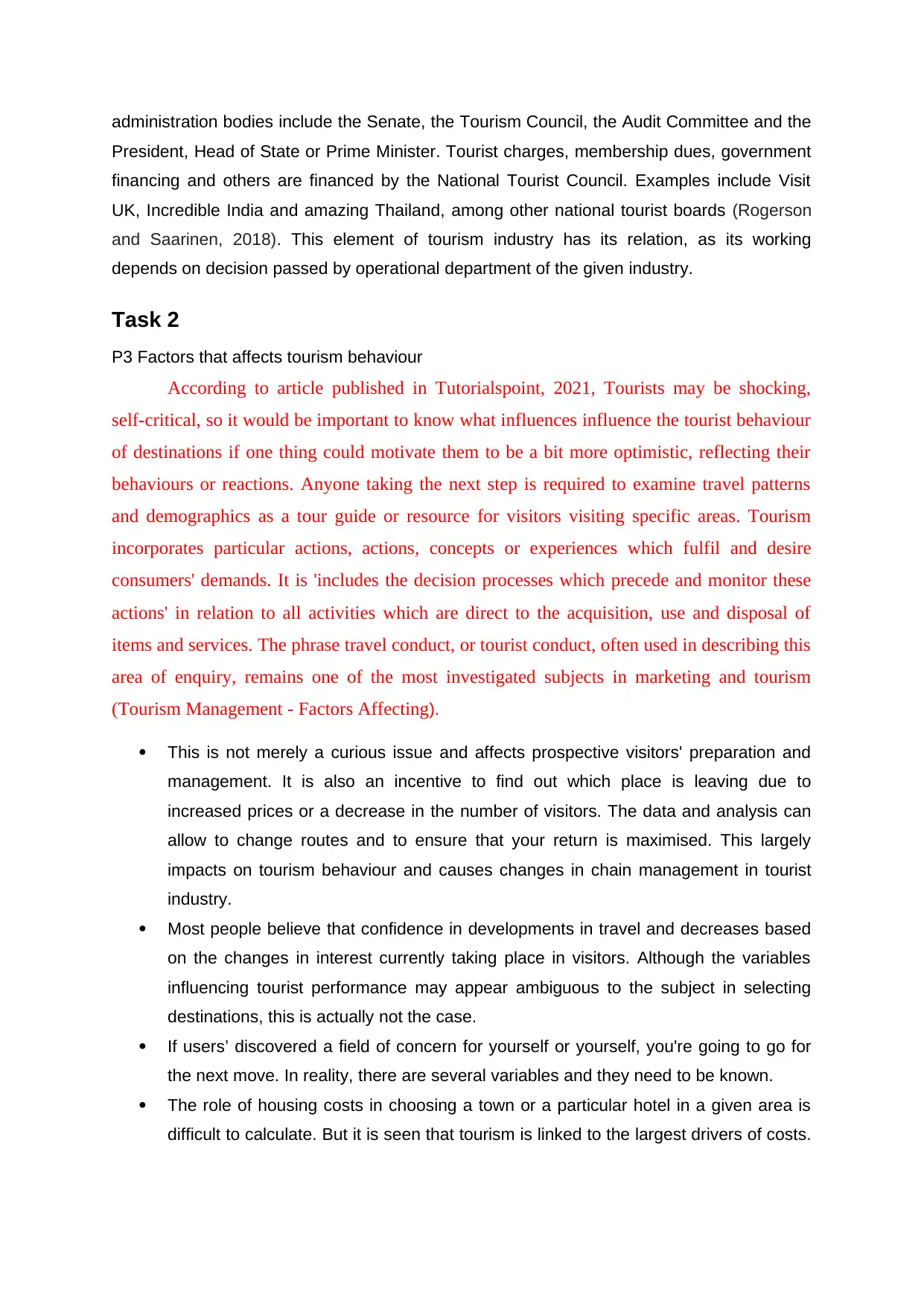
administration bodies include the Senate, the Tourism Council, the Audit Committee and the
President, Head of State or Prime Minister. Tourist charges, membership dues, government
financing and others are financed by the National Tourist Council. Examples include Visit
UK, Incredible India and amazing Thailand, among other national tourist boards (Rogerson
and Saarinen, 2018). This element of tourism industry has its relation, as its working
depends on decision passed by operational department of the given industry.
Task 2
P3 Factors that affects tourism behaviour
According to article published in Tutorialspoint, 2021, Tourists may be shocking,
self-critical, so it would be important to know what influences influence the tourist behaviour
of destinations if one thing could motivate them to be a bit more optimistic, reflecting their
behaviours or reactions. Anyone taking the next step is required to examine travel patterns
and demographics as a tour guide or resource for visitors visiting specific areas. Tourism
incorporates particular actions, actions, concepts or experiences which fulfil and desire
consumers' demands. It is 'includes the decision processes which precede and monitor these
actions' in relation to all activities which are direct to the acquisition, use and disposal of
items and services. The phrase travel conduct, or tourist conduct, often used in describing this
area of enquiry, remains one of the most investigated subjects in marketing and tourism
(Tourism Management - Factors Affecting).
This is not merely a curious issue and affects prospective visitors' preparation and
management. It is also an incentive to find out which place is leaving due to
increased prices or a decrease in the number of visitors. The data and analysis can
allow to change routes and to ensure that your return is maximised. This largely
impacts on tourism behaviour and causes changes in chain management in tourist
industry.
Most people believe that confidence in developments in travel and decreases based
on the changes in interest currently taking place in visitors. Although the variables
influencing tourist performance may appear ambiguous to the subject in selecting
destinations, this is actually not the case.
If users’ discovered a field of concern for yourself or yourself, you're going to go for
the next move. In reality, there are several variables and they need to be known.
The role of housing costs in choosing a town or a particular hotel in a given area is
difficult to calculate. But it is seen that tourism is linked to the largest drivers of costs.
President, Head of State or Prime Minister. Tourist charges, membership dues, government
financing and others are financed by the National Tourist Council. Examples include Visit
UK, Incredible India and amazing Thailand, among other national tourist boards (Rogerson
and Saarinen, 2018). This element of tourism industry has its relation, as its working
depends on decision passed by operational department of the given industry.
Task 2
P3 Factors that affects tourism behaviour
According to article published in Tutorialspoint, 2021, Tourists may be shocking,
self-critical, so it would be important to know what influences influence the tourist behaviour
of destinations if one thing could motivate them to be a bit more optimistic, reflecting their
behaviours or reactions. Anyone taking the next step is required to examine travel patterns
and demographics as a tour guide or resource for visitors visiting specific areas. Tourism
incorporates particular actions, actions, concepts or experiences which fulfil and desire
consumers' demands. It is 'includes the decision processes which precede and monitor these
actions' in relation to all activities which are direct to the acquisition, use and disposal of
items and services. The phrase travel conduct, or tourist conduct, often used in describing this
area of enquiry, remains one of the most investigated subjects in marketing and tourism
(Tourism Management - Factors Affecting).
This is not merely a curious issue and affects prospective visitors' preparation and
management. It is also an incentive to find out which place is leaving due to
increased prices or a decrease in the number of visitors. The data and analysis can
allow to change routes and to ensure that your return is maximised. This largely
impacts on tourism behaviour and causes changes in chain management in tourist
industry.
Most people believe that confidence in developments in travel and decreases based
on the changes in interest currently taking place in visitors. Although the variables
influencing tourist performance may appear ambiguous to the subject in selecting
destinations, this is actually not the case.
If users’ discovered a field of concern for yourself or yourself, you're going to go for
the next move. In reality, there are several variables and they need to be known.
The role of housing costs in choosing a town or a particular hotel in a given area is
difficult to calculate. But it is seen that tourism is linked to the largest drivers of costs.
Paraphrase This Document
Need a fresh take? Get an instant paraphrase of this document with our AI Paraphraser
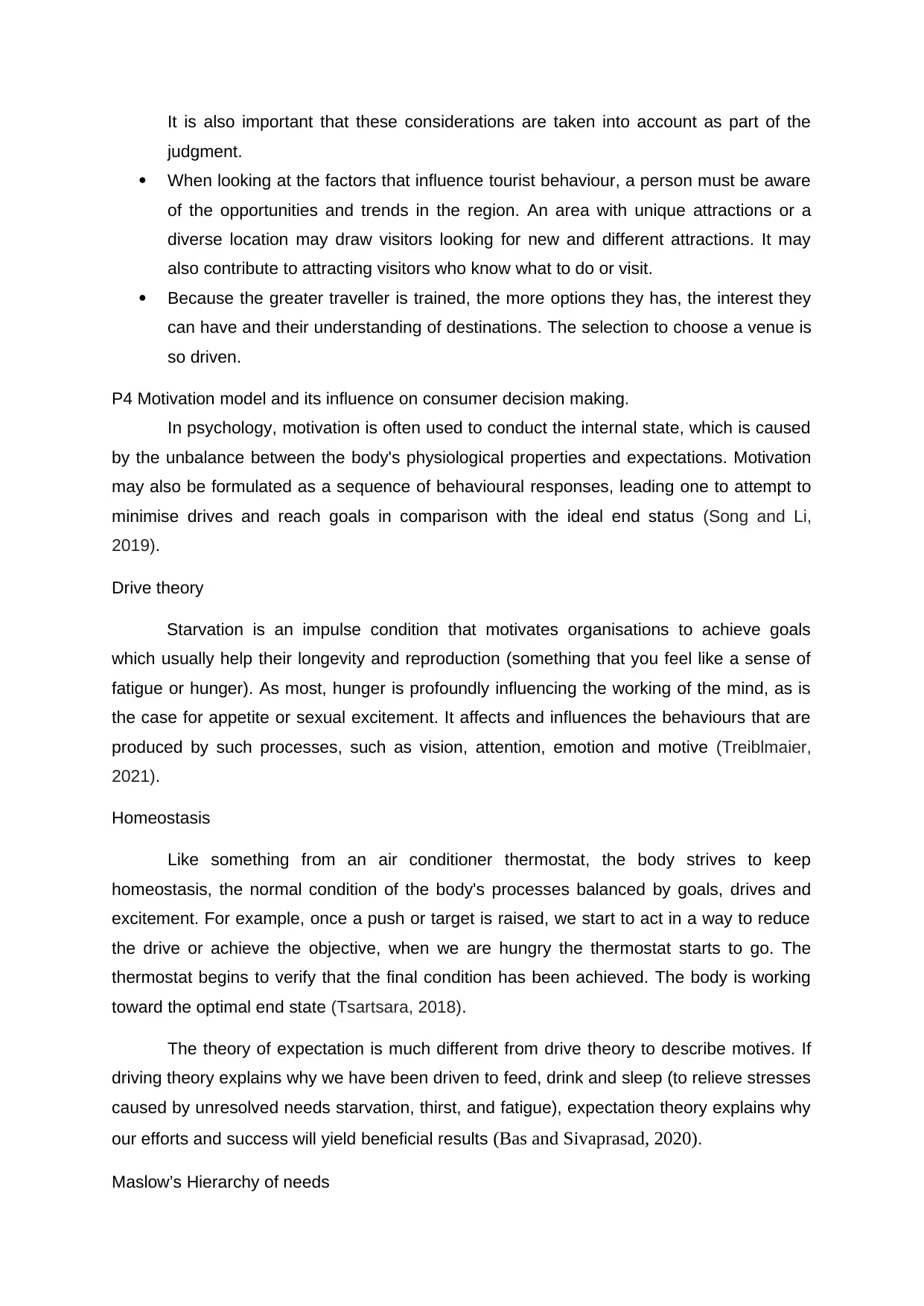
It is also important that these considerations are taken into account as part of the
judgment.
When looking at the factors that influence tourist behaviour, a person must be aware
of the opportunities and trends in the region. An area with unique attractions or a
diverse location may draw visitors looking for new and different attractions. It may
also contribute to attracting visitors who know what to do or visit.
Because the greater traveller is trained, the more options they has, the interest they
can have and their understanding of destinations. The selection to choose a venue is
so driven.
P4 Motivation model and its influence on consumer decision making.
In psychology, motivation is often used to conduct the internal state, which is caused
by the unbalance between the body's physiological properties and expectations. Motivation
may also be formulated as a sequence of behavioural responses, leading one to attempt to
minimise drives and reach goals in comparison with the ideal end status (Song and Li,
2019).
Drive theory
Starvation is an impulse condition that motivates organisations to achieve goals
which usually help their longevity and reproduction (something that you feel like a sense of
fatigue or hunger). As most, hunger is profoundly influencing the working of the mind, as is
the case for appetite or sexual excitement. It affects and influences the behaviours that are
produced by such processes, such as vision, attention, emotion and motive (Treiblmaier,
2021).
Homeostasis
Like something from an air conditioner thermostat, the body strives to keep
homeostasis, the normal condition of the body's processes balanced by goals, drives and
excitement. For example, once a push or target is raised, we start to act in a way to reduce
the drive or achieve the objective, when we are hungry the thermostat starts to go. The
thermostat begins to verify that the final condition has been achieved. The body is working
toward the optimal end state (Tsartsara, 2018).
The theory of expectation is much different from drive theory to describe motives. If
driving theory explains why we have been driven to feed, drink and sleep (to relieve stresses
caused by unresolved needs starvation, thirst, and fatigue), expectation theory explains why
our efforts and success will yield beneficial results (Bas and Sivaprasad, 2020).
Maslow’s Hierarchy of needs
judgment.
When looking at the factors that influence tourist behaviour, a person must be aware
of the opportunities and trends in the region. An area with unique attractions or a
diverse location may draw visitors looking for new and different attractions. It may
also contribute to attracting visitors who know what to do or visit.
Because the greater traveller is trained, the more options they has, the interest they
can have and their understanding of destinations. The selection to choose a venue is
so driven.
P4 Motivation model and its influence on consumer decision making.
In psychology, motivation is often used to conduct the internal state, which is caused
by the unbalance between the body's physiological properties and expectations. Motivation
may also be formulated as a sequence of behavioural responses, leading one to attempt to
minimise drives and reach goals in comparison with the ideal end status (Song and Li,
2019).
Drive theory
Starvation is an impulse condition that motivates organisations to achieve goals
which usually help their longevity and reproduction (something that you feel like a sense of
fatigue or hunger). As most, hunger is profoundly influencing the working of the mind, as is
the case for appetite or sexual excitement. It affects and influences the behaviours that are
produced by such processes, such as vision, attention, emotion and motive (Treiblmaier,
2021).
Homeostasis
Like something from an air conditioner thermostat, the body strives to keep
homeostasis, the normal condition of the body's processes balanced by goals, drives and
excitement. For example, once a push or target is raised, we start to act in a way to reduce
the drive or achieve the objective, when we are hungry the thermostat starts to go. The
thermostat begins to verify that the final condition has been achieved. The body is working
toward the optimal end state (Tsartsara, 2018).
The theory of expectation is much different from drive theory to describe motives. If
driving theory explains why we have been driven to feed, drink and sleep (to relieve stresses
caused by unresolved needs starvation, thirst, and fatigue), expectation theory explains why
our efforts and success will yield beneficial results (Bas and Sivaprasad, 2020).
Maslow’s Hierarchy of needs
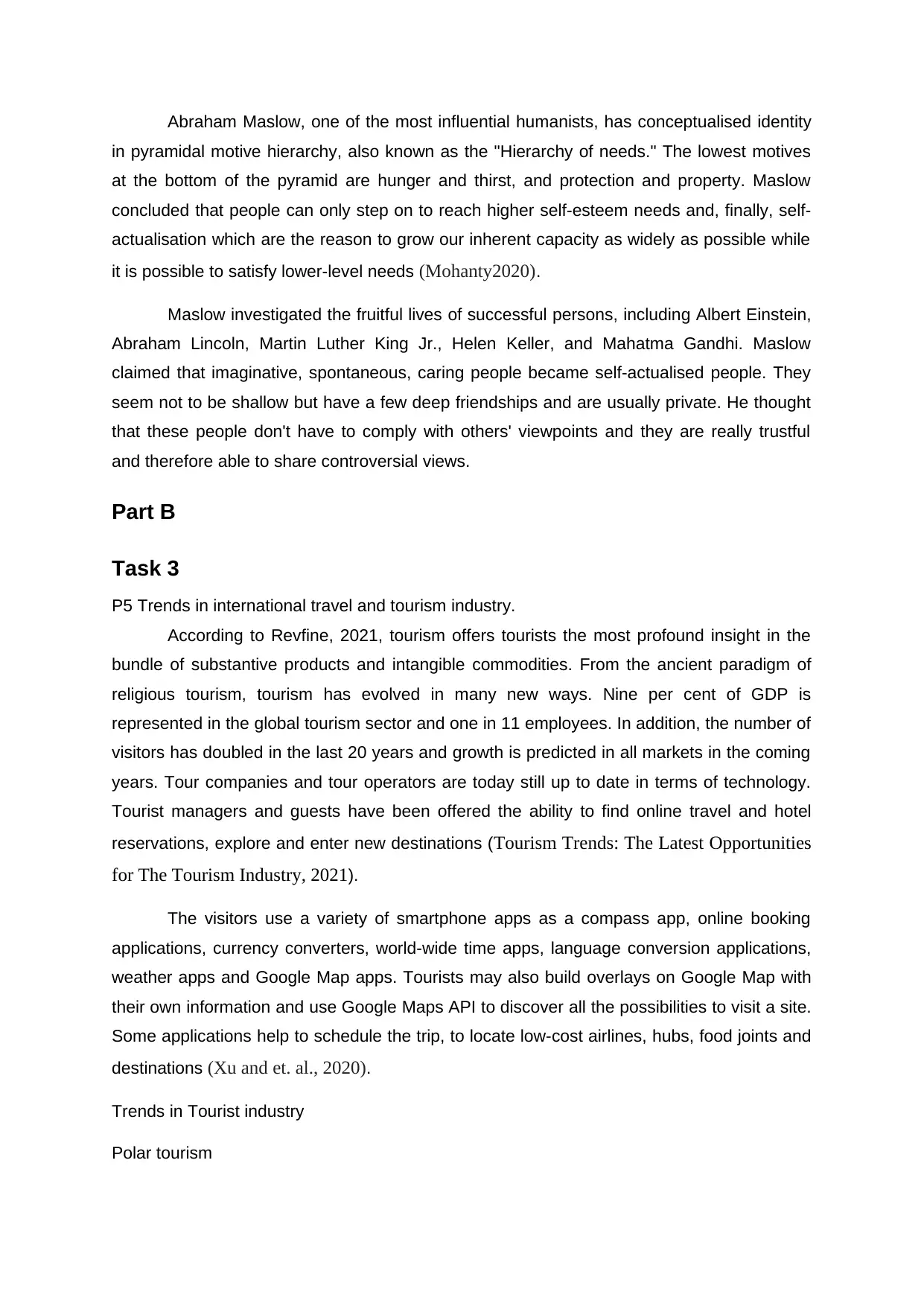
Abraham Maslow, one of the most influential humanists, has conceptualised identity
in pyramidal motive hierarchy, also known as the "Hierarchy of needs." The lowest motives
at the bottom of the pyramid are hunger and thirst, and protection and property. Maslow
concluded that people can only step on to reach higher self-esteem needs and, finally, self-
actualisation which are the reason to grow our inherent capacity as widely as possible while
it is possible to satisfy lower-level needs (Mohanty2020).
Maslow investigated the fruitful lives of successful persons, including Albert Einstein,
Abraham Lincoln, Martin Luther King Jr., Helen Keller, and Mahatma Gandhi. Maslow
claimed that imaginative, spontaneous, caring people became self-actualised people. They
seem not to be shallow but have a few deep friendships and are usually private. He thought
that these people don't have to comply with others' viewpoints and they are really trustful
and therefore able to share controversial views.
Part B
Task 3
P5 Trends in international travel and tourism industry.
According to Revfine, 2021, tourism offers tourists the most profound insight in the
bundle of substantive products and intangible commodities. From the ancient paradigm of
religious tourism, tourism has evolved in many new ways. Nine per cent of GDP is
represented in the global tourism sector and one in 11 employees. In addition, the number of
visitors has doubled in the last 20 years and growth is predicted in all markets in the coming
years. Tour companies and tour operators are today still up to date in terms of technology.
Tourist managers and guests have been offered the ability to find online travel and hotel
reservations, explore and enter new destinations (Tourism Trends: The Latest Opportunities
for The Tourism Industry, 2021).
The visitors use a variety of smartphone apps as a compass app, online booking
applications, currency converters, world-wide time apps, language conversion applications,
weather apps and Google Map apps. Tourists may also build overlays on Google Map with
their own information and use Google Maps API to discover all the possibilities to visit a site.
Some applications help to schedule the trip, to locate low-cost airlines, hubs, food joints and
destinations (Xu and et. al., 2020).
Trends in Tourist industry
Polar tourism
in pyramidal motive hierarchy, also known as the "Hierarchy of needs." The lowest motives
at the bottom of the pyramid are hunger and thirst, and protection and property. Maslow
concluded that people can only step on to reach higher self-esteem needs and, finally, self-
actualisation which are the reason to grow our inherent capacity as widely as possible while
it is possible to satisfy lower-level needs (Mohanty2020).
Maslow investigated the fruitful lives of successful persons, including Albert Einstein,
Abraham Lincoln, Martin Luther King Jr., Helen Keller, and Mahatma Gandhi. Maslow
claimed that imaginative, spontaneous, caring people became self-actualised people. They
seem not to be shallow but have a few deep friendships and are usually private. He thought
that these people don't have to comply with others' viewpoints and they are really trustful
and therefore able to share controversial views.
Part B
Task 3
P5 Trends in international travel and tourism industry.
According to Revfine, 2021, tourism offers tourists the most profound insight in the
bundle of substantive products and intangible commodities. From the ancient paradigm of
religious tourism, tourism has evolved in many new ways. Nine per cent of GDP is
represented in the global tourism sector and one in 11 employees. In addition, the number of
visitors has doubled in the last 20 years and growth is predicted in all markets in the coming
years. Tour companies and tour operators are today still up to date in terms of technology.
Tourist managers and guests have been offered the ability to find online travel and hotel
reservations, explore and enter new destinations (Tourism Trends: The Latest Opportunities
for The Tourism Industry, 2021).
The visitors use a variety of smartphone apps as a compass app, online booking
applications, currency converters, world-wide time apps, language conversion applications,
weather apps and Google Map apps. Tourists may also build overlays on Google Map with
their own information and use Google Maps API to discover all the possibilities to visit a site.
Some applications help to schedule the trip, to locate low-cost airlines, hubs, food joints and
destinations (Xu and et. al., 2020).
Trends in Tourist industry
Polar tourism
⊘ This is a preview!⊘
Do you want full access?
Subscribe today to unlock all pages.

Trusted by 1+ million students worldwide
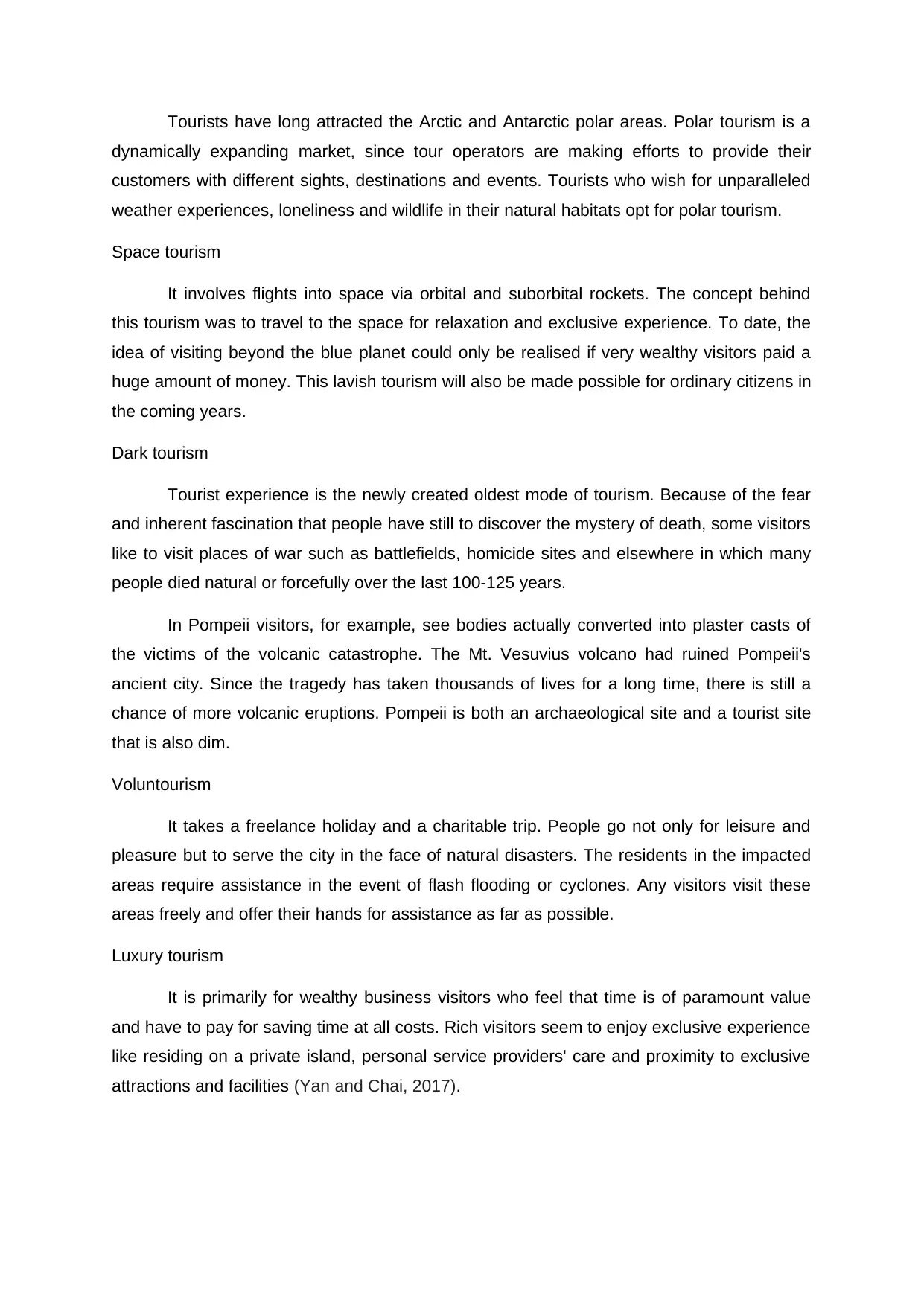
Tourists have long attracted the Arctic and Antarctic polar areas. Polar tourism is a
dynamically expanding market, since tour operators are making efforts to provide their
customers with different sights, destinations and events. Tourists who wish for unparalleled
weather experiences, loneliness and wildlife in their natural habitats opt for polar tourism.
Space tourism
It involves flights into space via orbital and suborbital rockets. The concept behind
this tourism was to travel to the space for relaxation and exclusive experience. To date, the
idea of visiting beyond the blue planet could only be realised if very wealthy visitors paid a
huge amount of money. This lavish tourism will also be made possible for ordinary citizens in
the coming years.
Dark tourism
Tourist experience is the newly created oldest mode of tourism. Because of the fear
and inherent fascination that people have still to discover the mystery of death, some visitors
like to visit places of war such as battlefields, homicide sites and elsewhere in which many
people died natural or forcefully over the last 100-125 years.
In Pompeii visitors, for example, see bodies actually converted into plaster casts of
the victims of the volcanic catastrophe. The Mt. Vesuvius volcano had ruined Pompeii's
ancient city. Since the tragedy has taken thousands of lives for a long time, there is still a
chance of more volcanic eruptions. Pompeii is both an archaeological site and a tourist site
that is also dim.
Voluntourism
It takes a freelance holiday and a charitable trip. People go not only for leisure and
pleasure but to serve the city in the face of natural disasters. The residents in the impacted
areas require assistance in the event of flash flooding or cyclones. Any visitors visit these
areas freely and offer their hands for assistance as far as possible.
Luxury tourism
It is primarily for wealthy business visitors who feel that time is of paramount value
and have to pay for saving time at all costs. Rich visitors seem to enjoy exclusive experience
like residing on a private island, personal service providers' care and proximity to exclusive
attractions and facilities (Yan and Chai, 2017).
dynamically expanding market, since tour operators are making efforts to provide their
customers with different sights, destinations and events. Tourists who wish for unparalleled
weather experiences, loneliness and wildlife in their natural habitats opt for polar tourism.
Space tourism
It involves flights into space via orbital and suborbital rockets. The concept behind
this tourism was to travel to the space for relaxation and exclusive experience. To date, the
idea of visiting beyond the blue planet could only be realised if very wealthy visitors paid a
huge amount of money. This lavish tourism will also be made possible for ordinary citizens in
the coming years.
Dark tourism
Tourist experience is the newly created oldest mode of tourism. Because of the fear
and inherent fascination that people have still to discover the mystery of death, some visitors
like to visit places of war such as battlefields, homicide sites and elsewhere in which many
people died natural or forcefully over the last 100-125 years.
In Pompeii visitors, for example, see bodies actually converted into plaster casts of
the victims of the volcanic catastrophe. The Mt. Vesuvius volcano had ruined Pompeii's
ancient city. Since the tragedy has taken thousands of lives for a long time, there is still a
chance of more volcanic eruptions. Pompeii is both an archaeological site and a tourist site
that is also dim.
Voluntourism
It takes a freelance holiday and a charitable trip. People go not only for leisure and
pleasure but to serve the city in the face of natural disasters. The residents in the impacted
areas require assistance in the event of flash flooding or cyclones. Any visitors visit these
areas freely and offer their hands for assistance as far as possible.
Luxury tourism
It is primarily for wealthy business visitors who feel that time is of paramount value
and have to pay for saving time at all costs. Rich visitors seem to enjoy exclusive experience
like residing on a private island, personal service providers' care and proximity to exclusive
attractions and facilities (Yan and Chai, 2017).
Paraphrase This Document
Need a fresh take? Get an instant paraphrase of this document with our AI Paraphraser
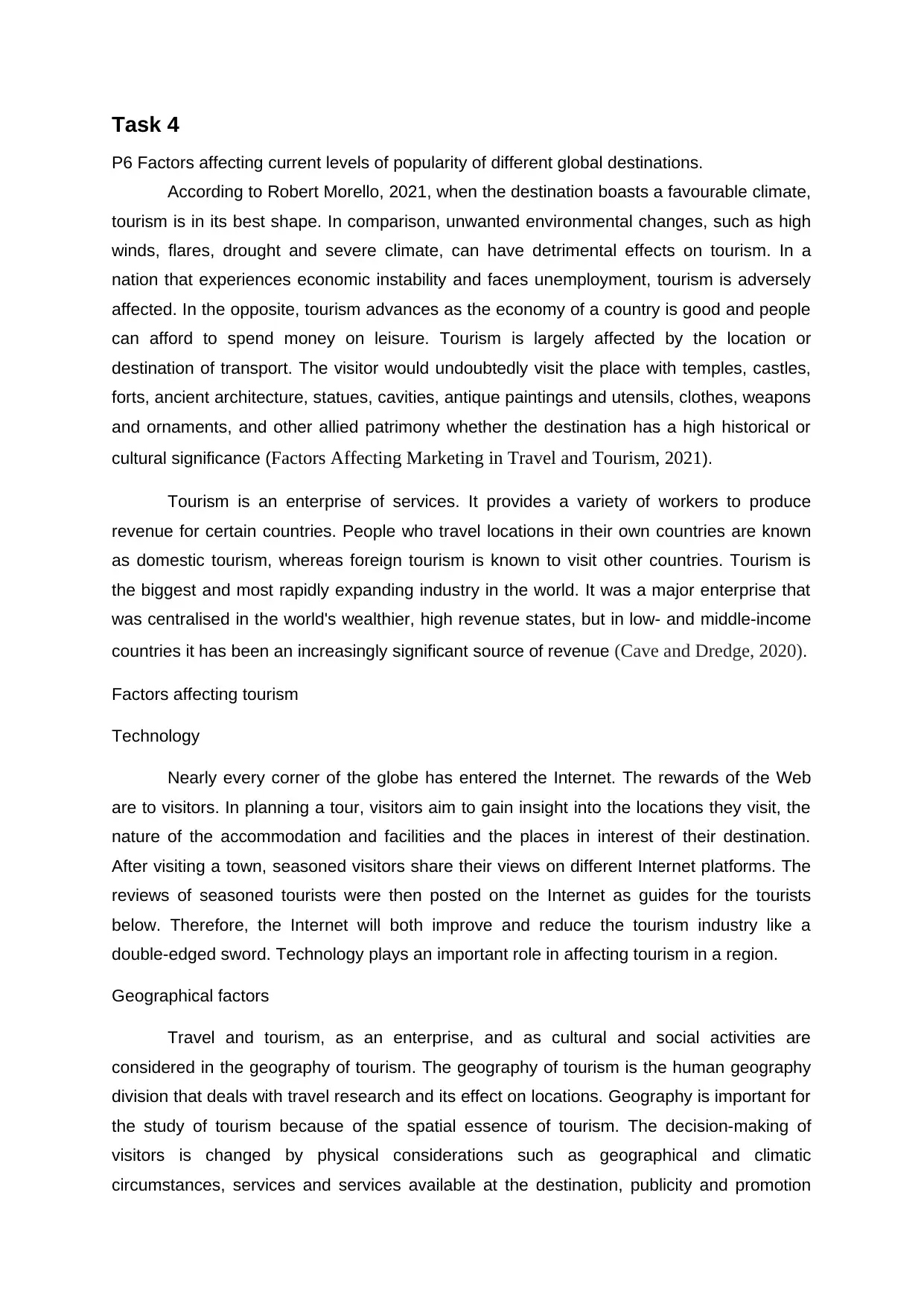
Task 4
P6 Factors affecting current levels of popularity of different global destinations.
According to Robert Morello, 2021, when the destination boasts a favourable climate,
tourism is in its best shape. In comparison, unwanted environmental changes, such as high
winds, flares, drought and severe climate, can have detrimental effects on tourism. In a
nation that experiences economic instability and faces unemployment, tourism is adversely
affected. In the opposite, tourism advances as the economy of a country is good and people
can afford to spend money on leisure. Tourism is largely affected by the location or
destination of transport. The visitor would undoubtedly visit the place with temples, castles,
forts, ancient architecture, statues, cavities, antique paintings and utensils, clothes, weapons
and ornaments, and other allied patrimony whether the destination has a high historical or
cultural significance (Factors Affecting Marketing in Travel and Tourism, 2021).
Tourism is an enterprise of services. It provides a variety of workers to produce
revenue for certain countries. People who travel locations in their own countries are known
as domestic tourism, whereas foreign tourism is known to visit other countries. Tourism is
the biggest and most rapidly expanding industry in the world. It was a major enterprise that
was centralised in the world's wealthier, high revenue states, but in low- and middle-income
countries it has been an increasingly significant source of revenue (Cave and Dredge, 2020).
Factors affecting tourism
Technology
Nearly every corner of the globe has entered the Internet. The rewards of the Web
are to visitors. In planning a tour, visitors aim to gain insight into the locations they visit, the
nature of the accommodation and facilities and the places in interest of their destination.
After visiting a town, seasoned visitors share their views on different Internet platforms. The
reviews of seasoned tourists were then posted on the Internet as guides for the tourists
below. Therefore, the Internet will both improve and reduce the tourism industry like a
double-edged sword. Technology plays an important role in affecting tourism in a region.
Geographical factors
Travel and tourism, as an enterprise, and as cultural and social activities are
considered in the geography of tourism. The geography of tourism is the human geography
division that deals with travel research and its effect on locations. Geography is important for
the study of tourism because of the spatial essence of tourism. The decision-making of
visitors is changed by physical considerations such as geographical and climatic
circumstances, services and services available at the destination, publicity and promotion
P6 Factors affecting current levels of popularity of different global destinations.
According to Robert Morello, 2021, when the destination boasts a favourable climate,
tourism is in its best shape. In comparison, unwanted environmental changes, such as high
winds, flares, drought and severe climate, can have detrimental effects on tourism. In a
nation that experiences economic instability and faces unemployment, tourism is adversely
affected. In the opposite, tourism advances as the economy of a country is good and people
can afford to spend money on leisure. Tourism is largely affected by the location or
destination of transport. The visitor would undoubtedly visit the place with temples, castles,
forts, ancient architecture, statues, cavities, antique paintings and utensils, clothes, weapons
and ornaments, and other allied patrimony whether the destination has a high historical or
cultural significance (Factors Affecting Marketing in Travel and Tourism, 2021).
Tourism is an enterprise of services. It provides a variety of workers to produce
revenue for certain countries. People who travel locations in their own countries are known
as domestic tourism, whereas foreign tourism is known to visit other countries. Tourism is
the biggest and most rapidly expanding industry in the world. It was a major enterprise that
was centralised in the world's wealthier, high revenue states, but in low- and middle-income
countries it has been an increasingly significant source of revenue (Cave and Dredge, 2020).
Factors affecting tourism
Technology
Nearly every corner of the globe has entered the Internet. The rewards of the Web
are to visitors. In planning a tour, visitors aim to gain insight into the locations they visit, the
nature of the accommodation and facilities and the places in interest of their destination.
After visiting a town, seasoned visitors share their views on different Internet platforms. The
reviews of seasoned tourists were then posted on the Internet as guides for the tourists
below. Therefore, the Internet will both improve and reduce the tourism industry like a
double-edged sword. Technology plays an important role in affecting tourism in a region.
Geographical factors
Travel and tourism, as an enterprise, and as cultural and social activities are
considered in the geography of tourism. The geography of tourism is the human geography
division that deals with travel research and its effect on locations. Geography is important for
the study of tourism because of the spatial essence of tourism. The decision-making of
visitors is changed by physical considerations such as geographical and climatic
circumstances, services and services available at the destination, publicity and promotion
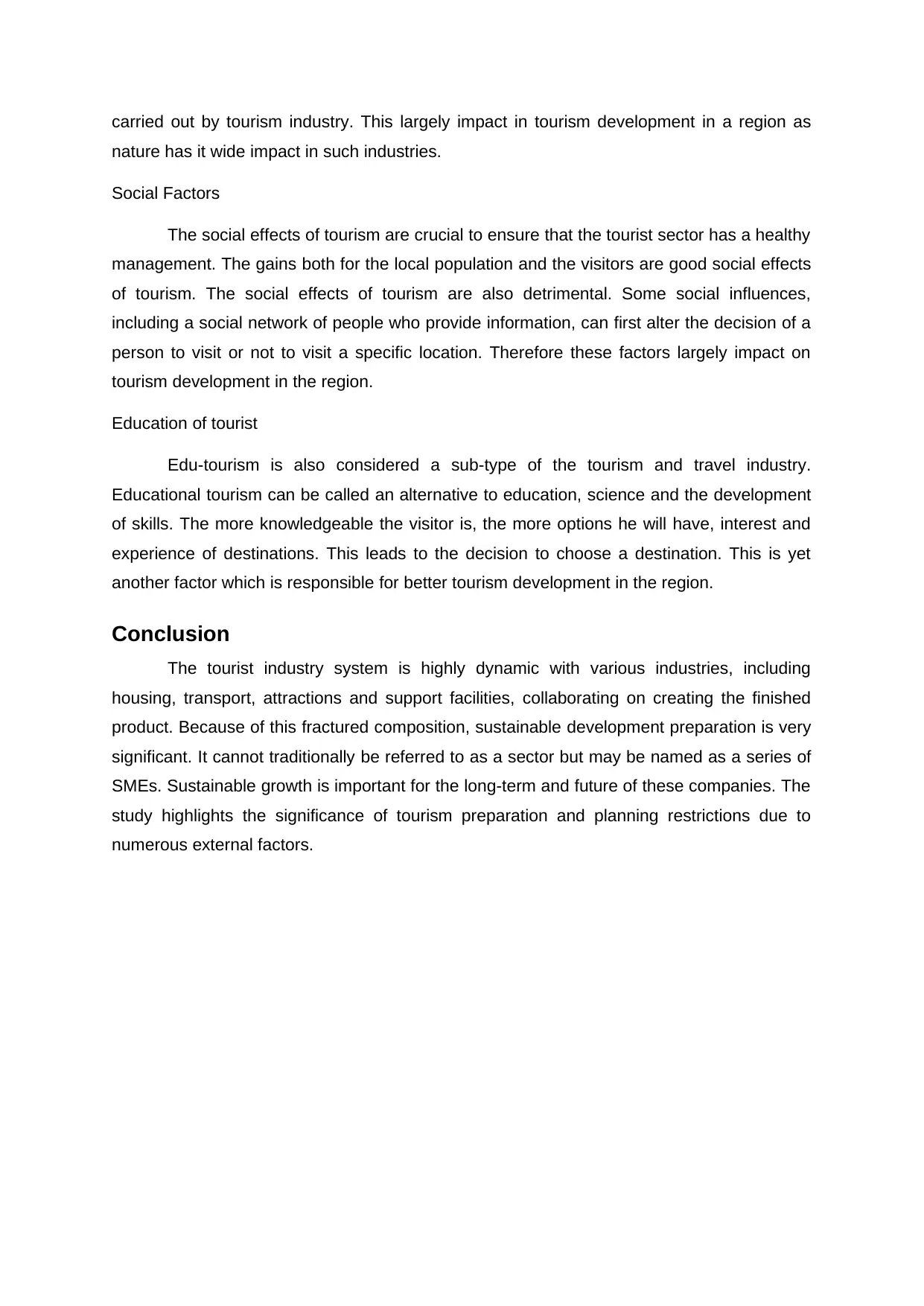
carried out by tourism industry. This largely impact in tourism development in a region as
nature has it wide impact in such industries.
Social Factors
The social effects of tourism are crucial to ensure that the tourist sector has a healthy
management. The gains both for the local population and the visitors are good social effects
of tourism. The social effects of tourism are also detrimental. Some social influences,
including a social network of people who provide information, can first alter the decision of a
person to visit or not to visit a specific location. Therefore these factors largely impact on
tourism development in the region.
Education of tourist
Edu-tourism is also considered a sub-type of the tourism and travel industry.
Educational tourism can be called an alternative to education, science and the development
of skills. The more knowledgeable the visitor is, the more options he will have, interest and
experience of destinations. This leads to the decision to choose a destination. This is yet
another factor which is responsible for better tourism development in the region.
Conclusion
The tourist industry system is highly dynamic with various industries, including
housing, transport, attractions and support facilities, collaborating on creating the finished
product. Because of this fractured composition, sustainable development preparation is very
significant. It cannot traditionally be referred to as a sector but may be named as a series of
SMEs. Sustainable growth is important for the long-term and future of these companies. The
study highlights the significance of tourism preparation and planning restrictions due to
numerous external factors.
nature has it wide impact in such industries.
Social Factors
The social effects of tourism are crucial to ensure that the tourist sector has a healthy
management. The gains both for the local population and the visitors are good social effects
of tourism. The social effects of tourism are also detrimental. Some social influences,
including a social network of people who provide information, can first alter the decision of a
person to visit or not to visit a specific location. Therefore these factors largely impact on
tourism development in the region.
Education of tourist
Edu-tourism is also considered a sub-type of the tourism and travel industry.
Educational tourism can be called an alternative to education, science and the development
of skills. The more knowledgeable the visitor is, the more options he will have, interest and
experience of destinations. This leads to the decision to choose a destination. This is yet
another factor which is responsible for better tourism development in the region.
Conclusion
The tourist industry system is highly dynamic with various industries, including
housing, transport, attractions and support facilities, collaborating on creating the finished
product. Because of this fractured composition, sustainable development preparation is very
significant. It cannot traditionally be referred to as a sector but may be named as a series of
SMEs. Sustainable growth is important for the long-term and future of these companies. The
study highlights the significance of tourism preparation and planning restrictions due to
numerous external factors.
⊘ This is a preview!⊘
Do you want full access?
Subscribe today to unlock all pages.

Trusted by 1+ million students worldwide
1 out of 15
Related Documents
Your All-in-One AI-Powered Toolkit for Academic Success.
+13062052269
info@desklib.com
Available 24*7 on WhatsApp / Email
![[object Object]](/_next/static/media/star-bottom.7253800d.svg)
Unlock your academic potential
Copyright © 2020–2025 A2Z Services. All Rights Reserved. Developed and managed by ZUCOL.





![Contemporary Travel and Tourism Industry Report - [University Name]](/_next/image/?url=https%3A%2F%2Fdesklib.com%2Fmedia%2Fimages%2Ftg%2F12fecf8882dc422db56286f3591ad2e5.jpg&w=256&q=75)